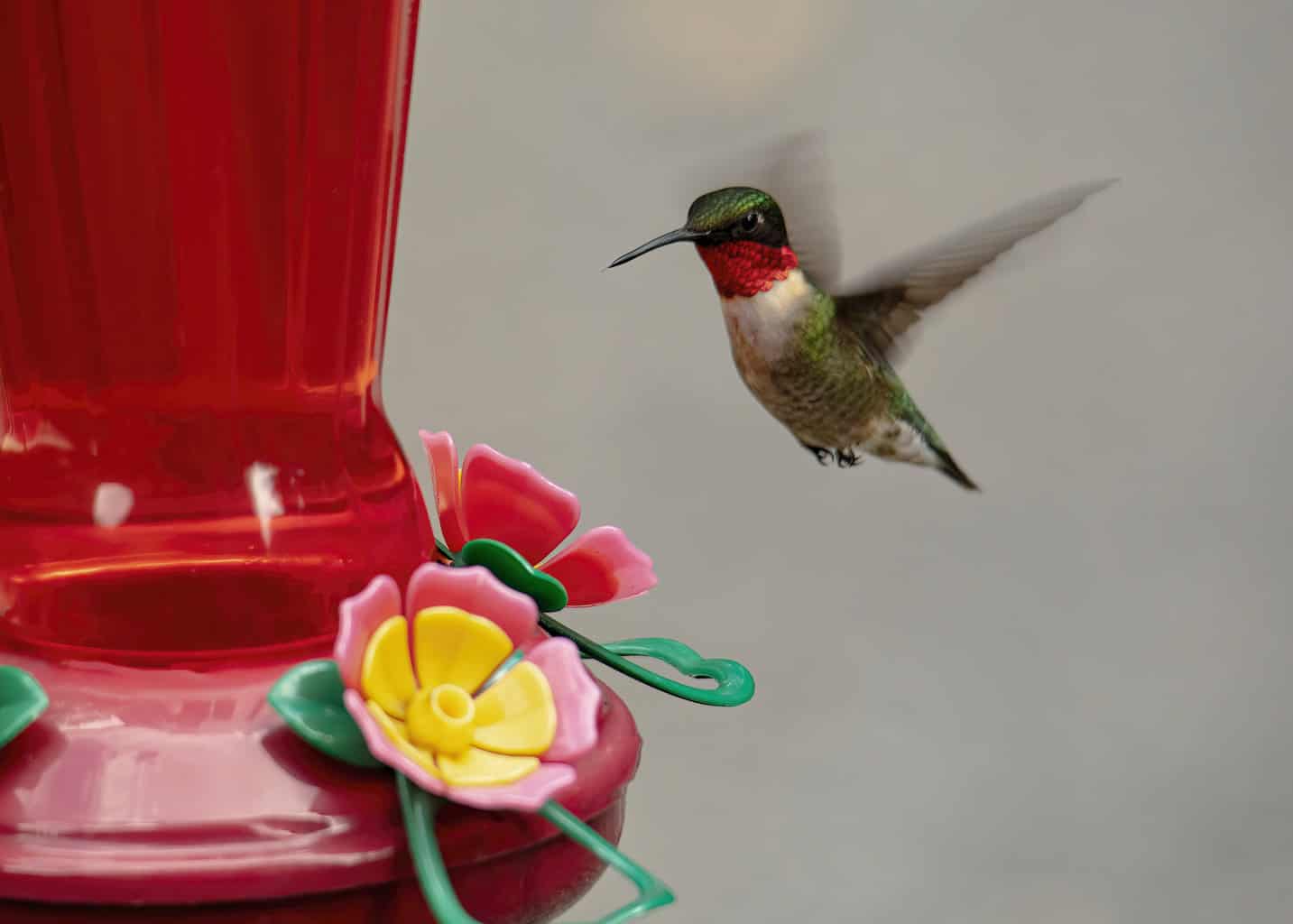Flowers are the cornerstone of a hummingbird’s diet, but this bird’s high metabolism also relies on eating small bugs like fruit flies, and sometimes, bird feeders set up by humans.
If you’re setting up a hummingbird feeder, you may wonder what the best nectar solution is for your ideal hummingbird habitat. Do hummingbirds prefer homemade nectar or is one off the shelf a better idea?
What’s The Difference Between Dyed and Un-Dyed Solutions?
Ultimately, there’s no way to know exactly what hummingbirds prefer, as they can’t tell us one way or the other, but in general, we can assume that the natural option is always better.
If you go down to a department or home improvement store and purchase hummingbird food, you’re probably going to get a pretty simple solution. It’s going to be water, sugar, preservatives, and (maybe) food coloring.
Popular Perky-Pet nectar concentrate, which is mixed with water before going into your plastic feeder, contains the following five ingredients: water, sucrose (sugar), Fd&c #40 (red dye), and two preservatives: potassium sorbate and sodium benzoate.
Those two preservatives are generally considered to be safe for human consumption, but there hasn’t been significant research done on hummingbirds. They generally aren’t as hotly debated as the food dye question, either.
Is Red Food Dye Harmful to Hummingbirds?
The question of whether red food dye in hummingbird feeders is harmful to our hummingbird friends or not is not one with a simple answer.
There currently isn’t strong scientific evidence linking dyes with hummingbird health problems, though some people are adamant they can cause health problems such as buildup in the birds’ kidneys.
The dye is at worst harmful, and at best, harmless but probably unnecessary.
The plastic feeders that the nectar is in are already colored red and yellow in many cases, and traditional flower nectar that provides the birds with most of their daily nutrition doesn’t have a color anyway.
Is It Okay To Buy Hummingbird Solution?
There’s nothing wrong with buying a hummingbird solution. Though it’s fairly simple to make your own, it’s tempting to save time and put out store-bought nectar.
People live busy lives, and there’s nothing wrong with saving yourself some time.
Plus, lots of hummingbird food manufacturers make dye-free nectar solutions (Perky-Pet included), and there are plenty of solutions made without the use of preservatives as well.
If you do want to make your own hummingbird food recipe, however, we have just what you need to get started.
Getting Started
A good rule of thumb is one part sugar to four parts water. Mix the solution well until it’s fully dissolved.
Just use regular table sugar (refined white sugar). Don’t use brown sugar, powdered sugar, honey, maple syrup, corn syrup, or anything else in your solution.
It may seem like anything sweet will do the trick, but simple is best. Other sugars or sweeteners contain additional ingredients that are not recommended for your hummingbird food recipes.
How Long Does Homemade Nectar Last?

If you make more than your feeder can hold, store the remainder in a sealed container in the refrigerator. It’s probably not a problem to store it at room temperature.
But you probably don’t want to attract fruit flies or other bugs, so it’s best to store it away.
If you refrigerate, leave the solution out at room temperature for a little bit to bring it to room temperature before placing it in your feeder.
Don’t store it for more than a week or two, and change the nectar in your feeder often, especially if it is warm outside, to prevent mold growth.
How To Preserve Your Nectar and Clean Your Feeder
Smithsonian’s National Zoo & Conservation Biology Institute recommends changing and cleaning hummingbird feeders daily but says it should be done at least twice a week in the summer and once a week in cooler weather at a minimum.
In addition to preventing mold, this will make the food more appealing to hummingbirds.
Hot water and sugar solutions aren’t likely to be super attractive to your yard’s hummers. They may stop once to check it out, but it’s not likely you’ll see them at the feeder again if the nectar inside is steaming hot.
There are varying opinions on whether you should boil the solution before putting it in your feeder.
The Smithsonian says there’s no need to boil, while the National Audubon Society recommends bringing the solution to a boil before placing it out for the beautiful hummingbirds.
If you do choose to boil it, always make sure to let the food sit and reach room temperature before putting it in your glass hummingbird feeder.
Where Should I Place My Feeder?
Put your glass hummingbird feeder out near trees in your yard. Hummingbirds nest and roost in trees at night, so putting the feeder next to the trees is the quickest way to get them to notice it.
You can also put your backyard hummingbird feeder near flowers, as that’s where the hummingbirds are likely to visit. It’s tempting to put your feeder near a window so that you can enjoy the birds up close, but this can sometimes increase the risk of birds hitting your windows.
If you do put a hummingbird feeder near your windows, put something on the window to deter the birds from flying through it.
Anything from masking tape to anti-collision decals you can buy online placed on the outside of your windows can help.
When placing these items, put them less than four inches apart. If you place them further apart, birds may try to fly through the gaps.

